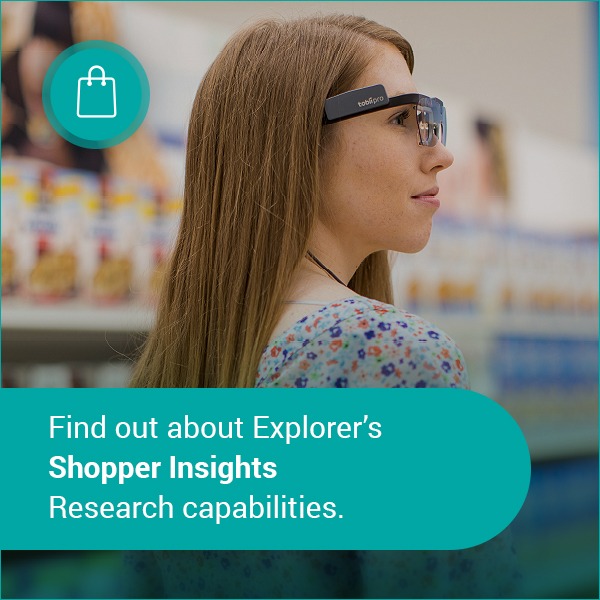In This Article
> Planogram Research Definition
> Why Invest in Planogram Research
> Innovation in Planogram Research
> Advanced Planogram Research Methods
> Mistakes to Avoid in Planogram Research
> Getting the Most from Planogram Research
> How to Present Planogram Research
Overview
The number of products available in stores has increased dramatically and space is at a premium. Introduction of new categories, segments and brands and expansion of retailer brands are putting pressure on overall store and shelf space.
These realities are also creating more complexity for time pressed shoppers who are unwilling to spend valuable time navigating shelves. They are looking for simplification in-store and turning to on-line shopping to save time.
Planogram testing is designed to address these challenges. Advanced research tools are now available to accurately measure shopper behavior and provide deeper insights to ensure the shelf has the ideal assortment and placement of products.
The shelf is the last opportunity to influence shoppers and the final chance to boost sales making it a vital component of any growth plan.
Planogram Research Definition
Whether you are launching a new product, defending share of shelf, looking to build basket size, rationalize sku’s or simplify the shopping experience, planogram research will help optimize the shelf and make the most of available space.
Regardless of channel, store format, banner or category today’s advanced research techniques can provide deeper insight into shopper’s decision making process and actual behavior at the shelf. Some important questions that Planogram Research can answer follow:
- What is the best assortment of products to maximize category sales?
- What is the best shelf position to grow my brand?
- What brand adjacencies are best for my brand?
- Will more facings boost sales? How many more?
- Is horizontal or vertical blocking the best strategy?
- Should the shelf be organized by segment, brand or consumer needs?
- How can I make it easier to shop the section?
A well designed and executed research plan choosing the right techniques will address these questions and more to help identify the best planogram to achieve your goals.
Who Uses Planogram Optimization Research?
Retailers and Manufacturers across industries recognize the need to optimize shelf space and are leveraging data and insights to accomplish this. While the goal of increasing sales is the same whether a retailer or manufacturer, the focus may differ somewhat.
Retailers, want to increase category sales and profitability. Their goal is to optimize existing shelf space across all sections. This includes having the right product assortment located in the right place including their own store brand. Manufacturer brands are only as relevant as their ability to satisfy their shoppers and increase category sales and profits.
Manufacturers want to increase brand sales and profit. Their goal is to have their brand in the optimal shelf position to be quickly seen and purchased by shoppers. While category growth may also result in brand growth, it’s about their brand first.
Manufacturers and retailers have, however, taken more of a partnership approach. This is based on realizing the importance of reaping benefits for all stakeholders. This doesn’t necessarily mean jointly conducting planogram research, although it could, it just means that goals are aligned and that outcomes benefit both parties.
Why Invest In Planogram Research?
The shelf is “the moment of truth.” It’s the last opportunity to influence shopper decisions.
Will they buy your brand or will you lose the sale to a competitor? Or, will shoppers get frustrated and move on, losing the sale all together?
Clearly, purchase decisions are driven by many factors including price, promotions or new competitors but, having the “right” planogram can increase your likelihood of making the sale.
A few questions can help you decide if planogram research is worth the investment or, if not doing it is worth the risk of lost sales.
First, how confident are you that the shelf is optimized to deliver best results? Changes to assortment, shelf location, adjacencies, number of facings or blocking strategies can make the difference in sales. Knowing which of these elements to change, and how, is rooted in understanding shopper behavior. Relying solely on industry learning or your own experience can result in missed opportunities.
Secondly, is the shelf organized to create a positive shopper experience? Ensuring the section is easy to navigate so shoppers can quickly find their brand of choice leads to higher levels of shopper satisfaction. Ask yourself, at what point might shoppers become frustrated and give up or switch brands as they discover another option as they search?
Thirdly, are you planning changes to your business? Planograms are changed during the business cycle across multiple channels and banners often creating the need for hundreds of new planograms. Clearly, testing every situation is unrealistic and unnecessary. So, how do you decide when you should invest in testing a planogram? Here are some situations where it can be most valuable:
- New Product Launch: When launching a new product, space must be created within existing shelf space. You want to understand what competitor do you target, how many facings are optimal for your new product or what are the best adjacencies to increase likelihood of being seen.
- Line extensions – varieties, sizes, premium segment: Here you need to create space without shrinking your existing facings. Again, which competitor do you target? What is the best position to up-sell shoppers to premium options, such as Omega, or encourage multiple purchases to build basket size?
- Defending space from a competitor: Sales data analysis shows a competitor is infringing on your “earned” shelf space. They may be getting more than their “fair share” of shelf and you must build a case for change.
- SKU Rationalization: You may have been asked to reduce your sku’s to create room for another brand or to expand an adjacent category. Planogram testing will demonstrate what assortment will add most value to the overall category while best protecting your brand’s space.
- Lagging Category Performance: Category growth may have decreased or you’re not keeping pace with market growth. As a Category Manager, you need to protect your section and improve performance. Optimizing the planogram – position, blocking or other changes – may help reverse the decline.
- Change in your brand share – becoming a larger brand. If your brand improves its share position, a change in planogram design may be warranted. This could mean more space, better shelf position or some other change.
- Section has become too crowded or complex: New entries or segments can complicate a section making it difficult and frustrating to find a product. This may suggest it’s time to re-visit your planogram design.
You may feel you know how to best manage the shelf in these situations, but keep in mind you don’t have the objectivity of your shopper, nor are you in the same frame of mind as a typical shopper. Shopper centric decisions will help you arrive at the ideal solution.
The above situations do not cover every example of when you will want to test your planogram. However, these are situations where planogram research is highly warranted.
Innovation In Planogram Research
Technology and a better understanding of behavioral science based research have dramatically improved market research, and planogram testing is no exception. These have opened the doors to more realistic test environments and techniques that provide deeper insights into purchase behavior.
Today’s challenging market environment and business demands require richer insights to gain a competitive edge and achieve desired growth. Thus, retailers and manufacturers alike are turning to research companies whose techniques provide deeper insight into decision making and who have the expertise to translate insights into actionable recommendations.
Thought leaders in market research are adopting and investing in building expertise in more advanced planogram research methods. Approaches such as Virtual Reality, to simulate shopping, and behavioral science based techniques, such as Eye Tracking are leading to planogram optimization that results in a difference to the bottom line.
Advanced Planogram Research Methods
Advanced planogram research used by leading manufacturers and retailers today include the following three benefits: (i) immersive shopping environments that best replicate real world shopping, (ii) techniques that capture actual versus reported behavior and emotional responses and (iii) ability for quick and inexpensive prototyping to evaluate multiple planograms.
These advanced approaches result in more reliable results and greater confidence in implementation.
The testing process itself is similar across approaches. Respondents are recruited and screened according to the study objectives, instructed to complete a shopping task and then typically complete a survey or interview after the shopping trip. Also, they all allow for quick prototyping of a variety of planogram options.
The differences are in two key areas: how the shopping environment is presented, each with its own pros and cons, and what biometric techniques are used. A brief description of each follows.
Shopping Environments
On-Line VR Simulated Shopping: This typically uses 2D or 3D technology to simulate the shopping environment, including the overall experience and shelf set up. Respondents are recruited from panels and, after downloading the required program, are asked to complete the shopping task on their own computer. They can click on products, view them up-close and make a purchase while eye tracking devices follow viewing patterns. This technique offers speed, flexibility and ease of testing across multiple geographies. It’s furthest from real life-like shopping, but has its benefits.
Central Location VR Simulated Shopping: This approach leverages VR technology projecting “life size” shelves and products onto a large screen. Respondents are recruited to a central location and asked to complete a shopping task as they “walk” through the store visiting the shelf to click on products for up-close viewing and place purchases into their cart. Eye Tracking is incorporated into the VR headset to follow actual viewing patterns, including when and where they pause and for how long. Benefits include context of a store environment, speed and flexibility for multiple tests across channels or banners. It also offers a high engagement level for respondents.
Shopper Lab: This approach also closely replicates a real-life shopping trip. Respondents are recruited to a central location site (shopper lab). The “Lab” consists of a number of aisles, up to 60 feet in length, which can include temperature controlled freezers, refrigerated sections and end aisle displays depending on the shopping task. Respondents literally walk down aisles to the shelf and interact with products putting their purchases into their cart as they would on an actual shopping trip. Eye tracking glasses are worn to follow and record their viewing patterns. The unique benefit of a shopper lab is that it best replicates an actual shopping experience. The layout can be easily re-configured for any type of retailer, offers speed and flexibility. It is restricted to fewer markets due to the facility size, but can be complimented with life-size VR approaches.
In-Store Testing: This is the “gold standard” in terms of being closest to real life shopping. However, it also has downsides. Respondents are recruited to complete a shopping task in the actual store. They can also wear eye tracking glasses to follow viewing patterns as in other approaches. Follow-up questions are asked at the shelf or after the shop. While it’s most realistic in terms of setting, this approach is labor intensive in setting up the test shelves in store and can create a disturbance for other shoppers.
These environments are all effectively used for planogram testing and, as with all research, budget, time, the category and other considerations will determine the best option.
Biometric Research
A variety of different Biometric research techniques are valuable for Planogram testing. They capture real time actual behavior and emotional responses to the Planogram providing highly reliable and actionable feedback.
The following describes a few of these techniques.
Eye tracking is a must for planogram testing! The eyes don’t lie. Eye tracking shows the exact scanning pattern of the shelf – the prime viewing zone, whether or when your brand is noticed and in what order, hot spots and where shoppers pause then move on or pick up the product. It’s an affordable and insightful way to gain deep understanding of behavior, and results will play a key role in identifying the best planogram option.
Today’s business demands require companies to maximize growth along every step of the path to purchase. This requires richer, more actionable insights. And, it means retailers and manufacturers are turning to research companies whose techniques offer the latest approaches and who have the experience to apply them and translate learning’s into actions.
Mistakes To Avoid In Planogram Research
The following covers some of the key watch out’s specific to planogram research. Methodology mistakes common to all research are not covered, but clearly are equally important.
Ensure test planograms can be executed. Be sure test options are acceptable to Retailers and can realistically be executed. Reducing space for a Retailer’s store brand or another popular brand, or excluding a unique shopper option, may not be accepted or executed. Know the parameters in advance!
Ensure test planograms have clear differences. Options must be different enough for shoppers to experience a real change. Adding just one more facing or making a small change in shelf location may not be discernable and will result in similar results, thus wasted time and money.
Use theory as guidelines only. There are many commonly held beliefs on best shelf position, blocking strategy or other shelving solutions. They can be helpful as guidelines for developing test options but don’t rely solely on these to create your final planogram.
The shopper may not trump all! Shoppers are most interested in a shopping experience that fulfills their needs, both the ease of shopping and availability of brands they want. At times, this may be at odds with the most profitable planogram option. Ensure priorities and the right balance of satisfying stakeholder goals are met.
Getting The Most From Planogram Research
Certain “musts” to getting the most out of any marketing research start with having clear, aligned objectives through to correct interpretation and compelling presentation of results. The following guidelines go beyond these with emphasis on getting the best out of planogram research.
Test as close to a real life shopping situation as possible. VR techniques have evolved dramatically to better replicate a realistic shopper experience. Shopper labs provide the additional benefit of a real life store environment. With these techniques you are closer to in-store while being able to control in market variables that may influence purchase.
Include volume estimation tools: The selected technique should ideally include an estimation of expected category growth and/or share change. While various market factors will effect this once implemented, it is a key measure for comparing across test options. Techniques should also ideally provide normative data for comparison, if possible. Research companies with these capabilities have their own proprietary measures.
Create A Win, Win, Win: Planograms that create a win for the retailer, manufacturer and shopper are most likely to be implemented.
- Manufacturers: Create a win for your customer or risk rejection of your recommended planogram. Thus, wasted time and money and the possibility of your competitor leading the planogram design. Unless your brand provides greater profit for the retailer or significant category growth, a planogram that favors your brand will not meet their needs.
- Retailers: Increasing category sales and profit while meeting shopper needs are of most importance to retailers. They recognize the importance of leading brands to their shopper and their bottom line, but they also know the value of their own store brands. In the end, it’s best to ensure business needs of these key stakeholders are clear up front.
- Shoppers: Providing an enjoyable shopping experience plays a big role in creating a positive image for both the retailer and the brand. If shoppers have a difficult time finding their preferred brand or a new variant, it creates the possibility of brand switching or satisfying that category purchase at another store. Ensure shopability measures are included in your research.
- Include Eye Tracking ……. Again! The importance of this warrants a second mention. Without this technique, results will fall well short of expectations!
Leading research companies apply the latest in technology, have the expertise and the experience to get the best return on your research investment. And, importantly, they will always keep your business needs and goals front and centre.
How To Present Planogram Research Results
The saying “a picture is worth a thousand words” should be taken to heart in presenting planogram research!
First, let your business goals and research objectives be your guide. The best market research presentations focus on what they know to be most important to their client and audience, not every “fascinating” piece of data.
Always start with the business goal and research objective followed by a review of the tested options and how the research was done. Be sure to spend more time explaining the technique if the audience is less familiar with it. This will save time and possible confusion in the end.
Provide recommendations and supporting rationale. Category growth, impact on share and ease of navigation for each planogram option are key areas of focus. After this, you can dive deeper into each of the Key Learnings and Insights.
Use visuals to bring results to life including heat maps (hot spots); scanning patterns and high/low viewing areas. These will speak for themselves!
You will now have provided the confidence that shopper needs are being satisfied and that shelf space is being best used to optimize business results at the shelf.
Done right with the right research partner will ensure your planogram is working as hard as possible to increase sales!



